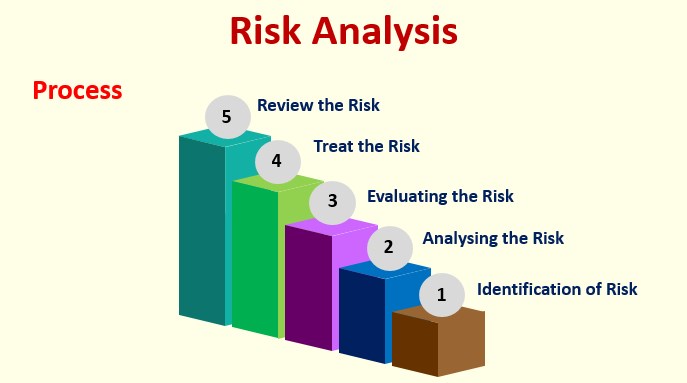Risk Analysis
Risk analysis is a way of identifying potential issues that could impact your projects. Through Risk Analysis, you can mitigate or avoid those risks. Managing possible surprises is the key to stable success.
What Is Risk Analysis
 Source: Wallstreetmojo.com
Source: Wallstreetmojo.com
What Problems Risk Analysis Helps to Solve
Why You Might Want the Risk Analysis
- Completion of risk analysis has the potential to avoid making huge losses.
- Risk analysis will help your business avoiding surprises.
- With Risk analysis, you can give better cost estimates.
- You can use new policies to prevent potential risks from happening.
- If an issue happens, you already have plans and some resources ready. You won't waste time and energy.
How to Implement the Risk Analysis
1. Identify Threats
Identifying the existing and possible threats that can be faced is the very first step in Risk Analysis. And there can be multiple sources that can give rise to these threats, some of them are listed below:
- Technical:
- Procedural – Failures of accountability or internal systems
- Technical – Bugs, Quality, Performace, Edge cases
- External:
- Natural - Earthquake, Tornado, Weather, Blackout, Pandemic
- Socio-political - Tax change, policies, laws, public trust, market reputation
- Operational - Disruptions due to suppliers,
- Management & Organization:
- Project – Going over budget, long loops, bad planning
- Team - Low bus factor, new team member
- Financial - Issues with money flow, funding issues
You can use many tools to uncover possible threats such as SWOT Analysis, Failure Mode, and Effects Analysis, while Scenario Analysis helps you explore possible future threats.
We use SWOT Analysis quite often.
SWOT Analysiis (Matrix)
SWOT Matrix is a tool to understand and identify strengths, weaknesses, opportunities, and threats related to your project. You can see it as themed brainstorming and evaluating.
 Source: SWOT
Source: SWOT
- Strengths: What gives you an advantage over others.
- Weaknesses: What gives you a disadvantage relative to others.
- Opportunities: What you could exploit to your advantage.
- Threats: What risks you could face.
In the context of Risk analysis, you should focus on Weaknesses and Threats.
2. Estimate Risk
After identification of threats that you can face, look at these two factors:
- The likelihood of these threats happening
- The possible impact of these threats (monetary costs)
You can calculate the risk value with the following formula:
Risk Value = Probability of Event A x Cost of Event A
3. Prepare for the Risks
Continue with Risk Response Planning. In short, your goal is to:
- Eliminate the risk
- Lower the risk probability
- Lower the risk impact
For example, if your risk is that an external graphic studio won't deliver their product on time, agree on penalties beforehand. Another way is to have guidelines and procedures that come into play when needed. For example, you are a marketing company, and you got hit by a troll raid (people disliking your post, meme-ing, and hurting your public image). In that case, you should have clear communication guidelines to go through it.
Common Pitfalls of the Risk Analysis
- The subjectiveness of evaluations that are done in risk analysis.
- Combination of risk evaluation or cost analysis is not possible.
- Within risk categories, there is a lack of differentiation.
- There is a high dependency on the experience of the team.
- Is pointless, if you create only vague plans out of it.
Resources for the Risk Analysis
- MarketBusinessNews: Defining Risk Analysis
- MindTools: Evaluating and Managing risks
- Spews: Importance of risk analysis
- Lavanya, N. & Malarvizhi, T. (2008). Risk analysis and management: a vital key to effective project management. Paper presented at PMI® Global Congress 2008—Asia Pacific, Sydney, New South Wales, Australia. Newtown Square, PA: Project Management Institute.
- SWOT analysis
Was the article helpful?
Want to write for DXKB?
Feel free to contribute. People from DXKB community will be more than happy.
Related articles
ALL ARTICLES
Bus Factor
A Bus Factor measures the minimum number of team members who have to be hit by a bus to put the project in jeopardy. The goal is to increase your Bus Factor as much as possible.
Read moreSoftware Documentation
Software documentation explains how the product works or how to use it. Different types of software documentation are created through the whole product development lifecycle.
Read moreREADME
A README is a text file that contains important information about the product. It is the first thing the user sees in the directory of the product. It helps the user to understand what does the product do and how to use it.
Read moreUpdating the Dependencies
Not updating dependencies makes your product more and more difficult to maintain and it can bring security risks.
Read moreUser Stories
In an Agile environment, teamwork is divided into small pieces called User Stories. It helps with sprint planning. They are written in a basic language.
Read moreALL ARTICLES
Contribution
We are happy you want to contribute to DXKB. Please choose your preferred way